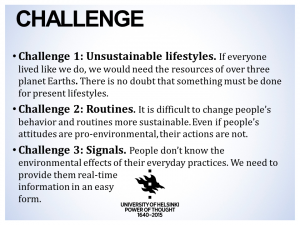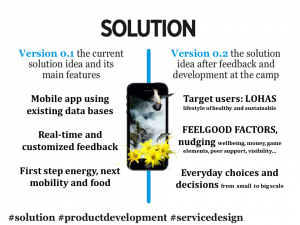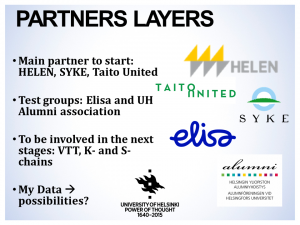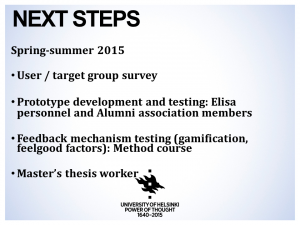Here’s our pitch at Helsinki Challenge Impact camp last week. We had inspiring two days, during which we developed our idea further with our partners Samuli Ruuskanen from Taito United and Minna Näsman and Jukka Helin from Helen.

Our challenge is the same as before: our lifestyles are unsustainable, so we need signals that tell us how to change our everyday routines more sustainable.

During the Impact camp, we clarified our solution to the challenge. It will still be a mobile application that uses existing databases to provide real-time, customized feedback on environmental effects of individual consumption. What is new is that we are going to target the application to the LOHAS (lifestyles of healthy and sustainability) group of users and to those people that are already concerned about environmental problems and are ready to change their behavior more sustainable – they just don’t know how to.
The Sustainability Tracker includes different “feelgood factors“: how more sustainable everyday choices improve also well-being or health, save money or help to gain credits in a game. In addition, by sharing her carbon footprint on Facebook, the user of Sustainability Tracker can make her choices visible, get peer support for these choices, and compare her results to others’.

Our assumption is that the LOHAS user group uses the application because they are interested in their results and are eager to find ways to live more sustainably. Hence, the impact of Sustainability Tracker is smaller in the beginning. However, there is a great upscaling potential as more sustainable choices become visible and encourage also other user groups.
The carbon footprint of an average Finn is 9 tonnes per year. As Sustainability Tracker makes it easier for users to find the best ways for them to reduce their environmental impacts, we estimate that the reduction in carbon footprint can be approximately one tonne per year. Replacing 100 kilometers of driving by cycling, for example, decreases carbon footprint by 0.5 tonnes.

As the number of Sustainability Tracker users increases, so does the impact. The more users see the environmental effects of their consumption and change their everyday living more sustainable accordingly, the more acceptable does the sustainable living become.
We acknowledge the fact that at some point the Sustainability Tracker users face the point where making more sustainable choices is no more possible. However, at this point significant reductions have already been made and – hopefully – new, more sustainable routines and practices have taken place.

At the moment we are developing Sustainability Tracker with our closest partners: Helen, Finnish Environment Institute, and Taito United. We also have test group collaboration with Elisa and Helsinki University Alumni Association.
We are looking for new partners and expertise in areas of mobile technologies, mobility tracking and retail. If you are interested, contact our team leader Kaisa!

Our next steps in developing Sustainability Tracker are as follows: at the moment we have a student group focusing on gamification in individual decision making. We are also recruiting a Master’s Thesis worker to focus on feedback mechanisms and conduct a study on these mechanisms. We have partners from Elisa and University of Helsinki Alumni association, via whom we can get test groups for testing both the feedback mechanisms and the prototypes of the application.
After the summer, we should have more information on personal feedback mechanisms and their functionality, as well as preliminary results from the prototype testing!







